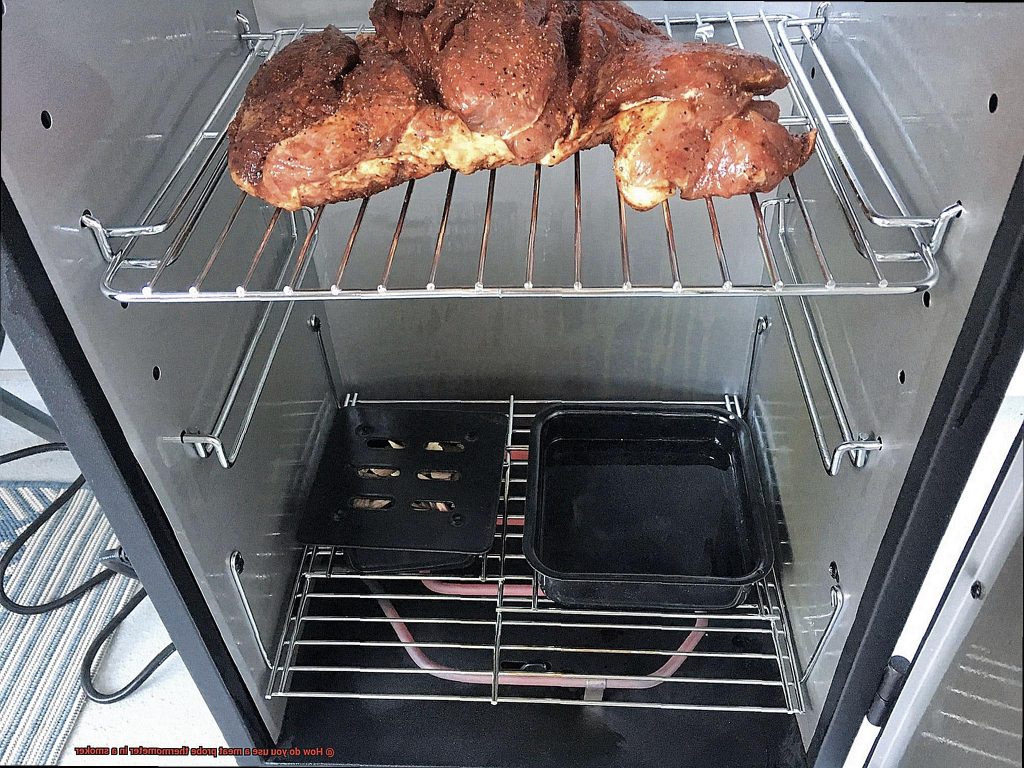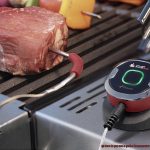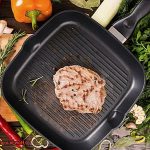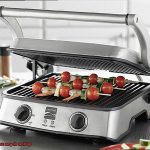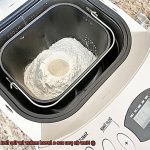Imagine this: the sun is shining, the birds are singing, and your backyard is filled with friends and family eagerly awaiting their first bite of your slow-smoked barbecue. You’ve spent hours marinating and seasoning your meat, carefully setting up your smoker to ensure everything is perfect. But how can you guarantee that your meat is cooked just right? The answer lies in using a meat probe thermometer.
In this blog post, we’re going to explore the art and science of using a meat probe thermometer in a smoker. This isn’t just any old thermometer – it’s a tool that can unlock the secret to mouth-watering, tender meat that’s cooked to perfection. We’ll cover everything from choosing the right thermometer for the job to inserting it properly into your meat and hitting the desired temperature for your preferred level of doneness.
Gone are the days of playing guessing games with cooking times and temperatures. With a trusty meat probe thermometer by your side, you can rest assured that every cut of meat will be cooked to perfection, resulting in a meal that’s both delicious and satisfying. So sit back, crack open a cold one, and let’s dive into the world of using a meat probe thermometer in a smoker.
Contents
Choosing the Right Type of Thermometer
Smoking meat is an art form that requires precision and the right tools. One of the most important tools in a pitmaster’s arsenal is a thermometer. But with so many options on the market, how do you choose the right one for your smoking needs? Here are some factors to consider:
Type of Thermometer
First things first, decide whether you want to go digital or analog. Digital thermometers are more accurate and easier to read, but they can be pricier. Analog thermometers are cheaper, but they can be harder to read and less accurate. For smoking meat, a digital thermometer is highly recommended.
Temperature Range
The temperature range of the thermometer is crucial. Some thermometers are designed specifically for low-temperature smoking, while others can handle higher temperatures for grilling or baking. Make sure you choose a thermometer that can handle the temperature range you need for smoking meat.
Probe Length
The length of your thermometer probe is also important. It should be long enough to reach the thickest part of the meat, but not so long that it touches the bone or the smoker itself. A good rule of thumb is to choose a probe that is at least 4 inches long.
Additional Features
Finally, consider any additional features that may be important to you. Some thermometers come with alarms that will sound when your meat reaches a certain temperature, while others have Bluetooth connectivity so you can monitor your meat from your phone. Some even have a built-in timer or display both Fahrenheit and Celsius readings.
Preparing the Meat for Insertion
Then, let’s talk about preparing the meat for insertion when using a meat probe thermometer in a smoker. This step is crucial in achieving that perfectly cooked, smoky goodness you crave.
Firstly, let’s talk about drying the meat. Excess moisture will throw off our temperature readings and leave us with soggy meat. So, before inserting the probe, it’s essential to pat your meat dry with paper towels.
Now, let’s locate the thickest part of the meat. This will give us the most accurate temperature reading. But be careful not to touch any bones, as this can affect the readings. Remember to insert deep enough into the meat without going too far and reaching the other side.
To ensure accuracy, we need to avoid any large pockets of fat or areas with bones when inserting the probe. These can throw off our temperature readings and leave us with undercooked or overcooked meat. Also, keep your probe away from the heat source of your smoker to prevent false alarms.
Once we’ve inserted our probe, we need to secure it in place using clips or other means provided by our thermometer manufacturer. We don’t want our probe moving around during cooking and giving us inaccurate temperature readings. It would be like having a false note in our symphony.
Last but not least, don’t forget to clean and sanitize your thermometer probe before and after each use. We want to prevent any cross-contamination of bacteria and keep ourselves and our guests safe.
Inserting the Thermometer in the Thickest Part of the Meat
Then get ready to master the art of inserting a thermometer in the thickest part of your meat. This critical step is key to achieving that perfect, juicy, and smoky goodness that we all crave. Let’s dive into the nitty-gritty details of how to properly insert a thermometer into the thickest part of the meat when using a meat probe thermometer in a smoker.
Step 1: Find the Thickest Part of the Meat
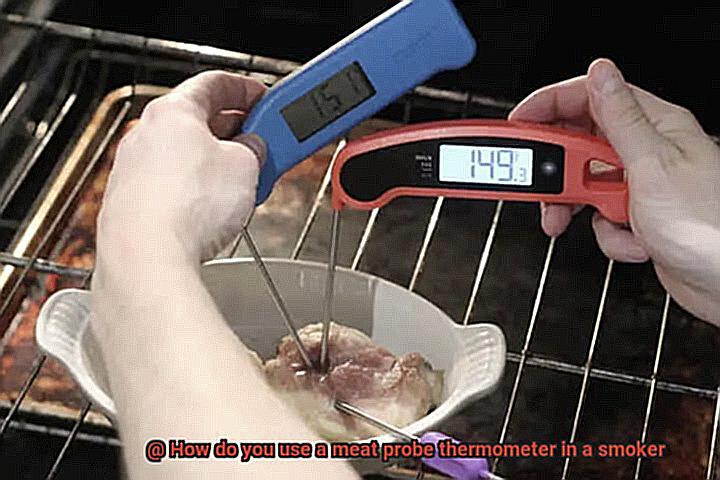
To get started, identify where the thickest part of your meat lies. Typically, it will be in the center, which is where you will want to insert your thermometer for an accurate reading. However, if your meat is an irregular shape, you may need to take multiple readings in different locations to ensure accuracy.
Step 2: Insert at a 90-Degree Angle
Now it’s time to insert your thermometer. Make sure that you insert it at a 90-degree angle into the center of the thickest part of your meat. Avoid touching any bones or gristle as this can impact your temperature reading.
Step 3: Insert Once Only
When using a meat probe thermometer in a smoker, it’s essential to only insert it once. Repeatedly piercing the meat with a thermometer can cause juices to escape, which can dry out your meat and affect its flavor.
So, go ahead and pat that meat dry like a loving parent, locate the thickest part like a treasure hunter seeking gold, and secure that probe in place like a conductor ensuring every note is played perfectly. And don’t forget to clean and sanitize your thermometer probe before and after each use to prevent any unwanted surprises.
Connecting the Probe to the Base Unit and Placing it Outside of the Smoker
Connecting the probe to the base unit and placing it outside of the smoker is an essential step for achieving perfectly cooked, juicy meat every time. Here’s what you need to know to make it happen:
- Step one: Before connecting the probe to the base unit, ensure that both are clean and dry. Don’t let any moisture interfere with your temperature readings. Most meat probe thermometers come with color-coded wires or connectors to help you avoid mixing up your probes.
- Step two: Once your probe is connected, it’s time to position it outside of the smoker. Why? Because constantly opening the smoker to check the temperature can cause heat loss and affect cooking times. Instead, attach the probe to a long wire that leads outside of the smoker, allowing you to monitor the temperature from a distance.
- Step three: Be mindful of where you place the probe. Experts suggest inserting it into the thickest part of the meat for more accurate readings, while others recommend placing it near but not touching the bone. Whichever method you choose, make sure your wire isn’t touching anything hot or dangerous. Use a wire clip or other device to secure it in place and keep it away from potential hazards.
Interpreting Readings Based on Different Types of Meats
Smoking meats in a smoker can be a delightful culinary experience. However, to ensure the meat is cooked to perfection, it’s essential to use a meat probe thermometer. The thermometer helps in interpreting the readings correctly when cooking different types of meats. Here are five crucial sub-sections on how to interpret the meat probe thermometer readings while cooking different types of meats in a smoker.
Ideal Temperature Range for Different Meats
Different types of meat require specific internal temperatures to be safe for consumption. For instance, chicken should be cooked to an internal temperature of 165°F, while beef can be cooked to a lower internal temperature of 145°F for medium-rare. Researching and understanding the ideal temperature range for each type of meat is crucial before smoking them.
Consider the Cut of Meat
The thickness and cut of the meat significantly affect its cooking time and ideal internal temperature. For example, thicker cuts require more time to cook and may need higher internal temperatures to ensure they are thoroughly cooked. Bone-in pieces of meat may take longer to cook due to heat distribution around the bone.
Avoid Bones and Fatty Areas
While using the meat probe thermometer, ensure that you do not hit any bones or fatty areas since these can give inaccurate readings, making it challenging to interpret the true internal temperature of the meat.
Choose a High-Quality Thermometer
Not all meat probe thermometers are suitable for use in smokers or can withstand high temperatures. Choosing a high-quality thermometer will give you more accurate readings, making it easier to interpret the internal temperature of your meat.
Always Err on the Side of Caution
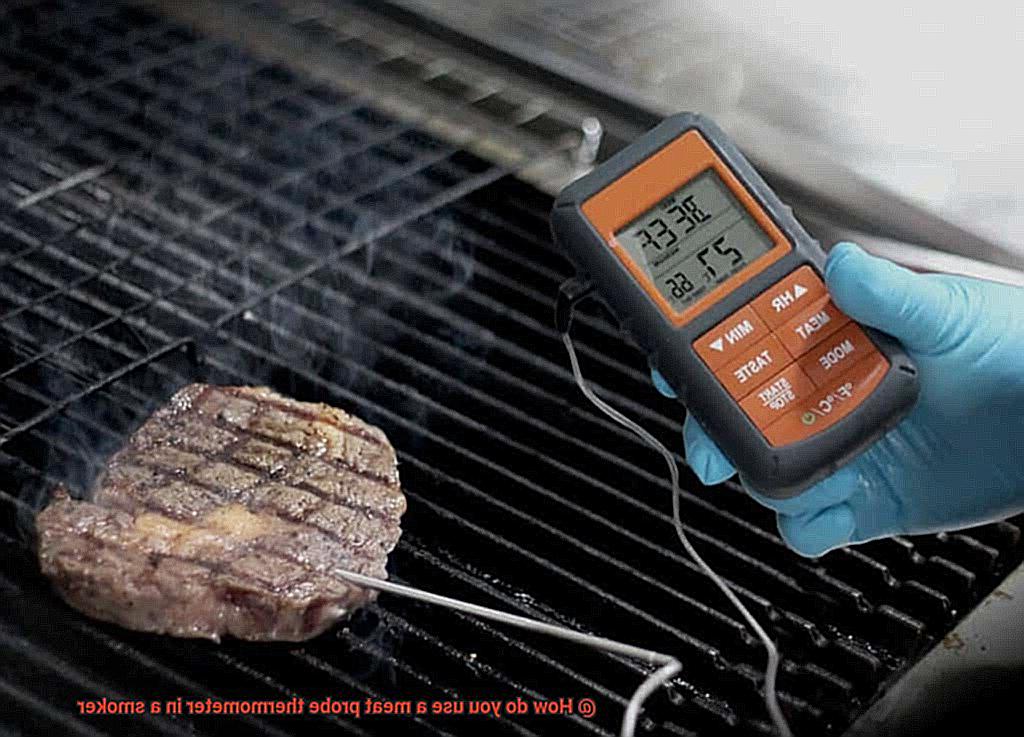
When in doubt, always cook your meat to its recommended internal temperature range. This ensures that any harmful bacteria has been killed and that your meat is both safe and delicious to eat.
Ensuring Accuracy with Calibration Checks

Even the most reliable thermometer can lose its accuracy over time, which is why regular calibration checks are crucial to ensure accurate readings every time.
Calibration checks involve comparing the readings of your thermometer to a known accurate source. This can be done by using either a boiling water test or an ice water test. To perform the boiling water test, bring a pot of water to a rolling boil and insert the probe of your thermometer into the water without touching the sides or bottom of the pot. The thermometer should read 212°F (100°C) at sea level. If it doesn’t, adjust the thermometer accordingly or replace it if it cannot be adjusted.
For the ice water test, fill a glass with ice and cold water and insert the probe of your thermometer into the mixture, making sure not to touch the sides or bottom of the glass. The temperature should read 32°F (0°C). If it doesn’t, adjust or replace the thermometer as necessary.
Regular calibration checks are important for several reasons. Firstly, it ensures safety by reducing the risk of undercooked or overcooked meat, which can lead to foodborne illnesses. Secondly, accurate readings ensure that your food is cooked consistently every time. This is especially important if you’re cooking for guests or catering events where consistency is key. Lastly, regular calibration checks can help prolong the life of your thermometer by ensuring that it’s working properly and not causing any damage to your meat due to inaccurate readings.
It is recommended to perform these calibration checks at least once a year or more frequently if you use your thermometer frequently or drop it. In addition, always follow the manufacturer’s instructions for proper care and use of your meat probe thermometer to ensure accurate readings and safe cooking practices.
Cleaning and Storing Your Thermometer Properly
One of the most important tools in your arsenal is your meat probe thermometer. Ensuring that it stays accurate and reliable is essential for cooking your food to perfection. This is why cleaning and storing your thermometer properly is crucial.
Firstly, after each use, it is important to clean your thermometer thoroughly. Use a damp cloth with soapy water to wipe the probe and cable carefully. Bacteria love to grow on food residue, so keeping your thermometer clean is vital in preventing contamination and foodborne illnesses.
Once you have cleaned your thermometer, make sure it is completely dry before storing it. The probe should be inserted into its protective sheath or case to prevent any damage or contamination. If your thermometer does not come with a protective cover, wrap the probe in a clean towel or cloth. This will keep it safe and prevent any damage.
Now, where should you store your thermometer? A cool and dry place away from direct sunlight and heat sources is ideal. This will prevent any damage to the electronic components and ensure that your thermometer stays accurate.
It is also important to calibrate your meat probe thermometer regularly to ensure accurate readings. Calibration involves adjusting the thermometer to match a known temperature accurately. This can be done by placing the probe in ice water and adjusting the reading to 32°F or boiling water and adjusting the reading to 212°F at sea level.
Tips for Perfectly Cooked Smoked Meats
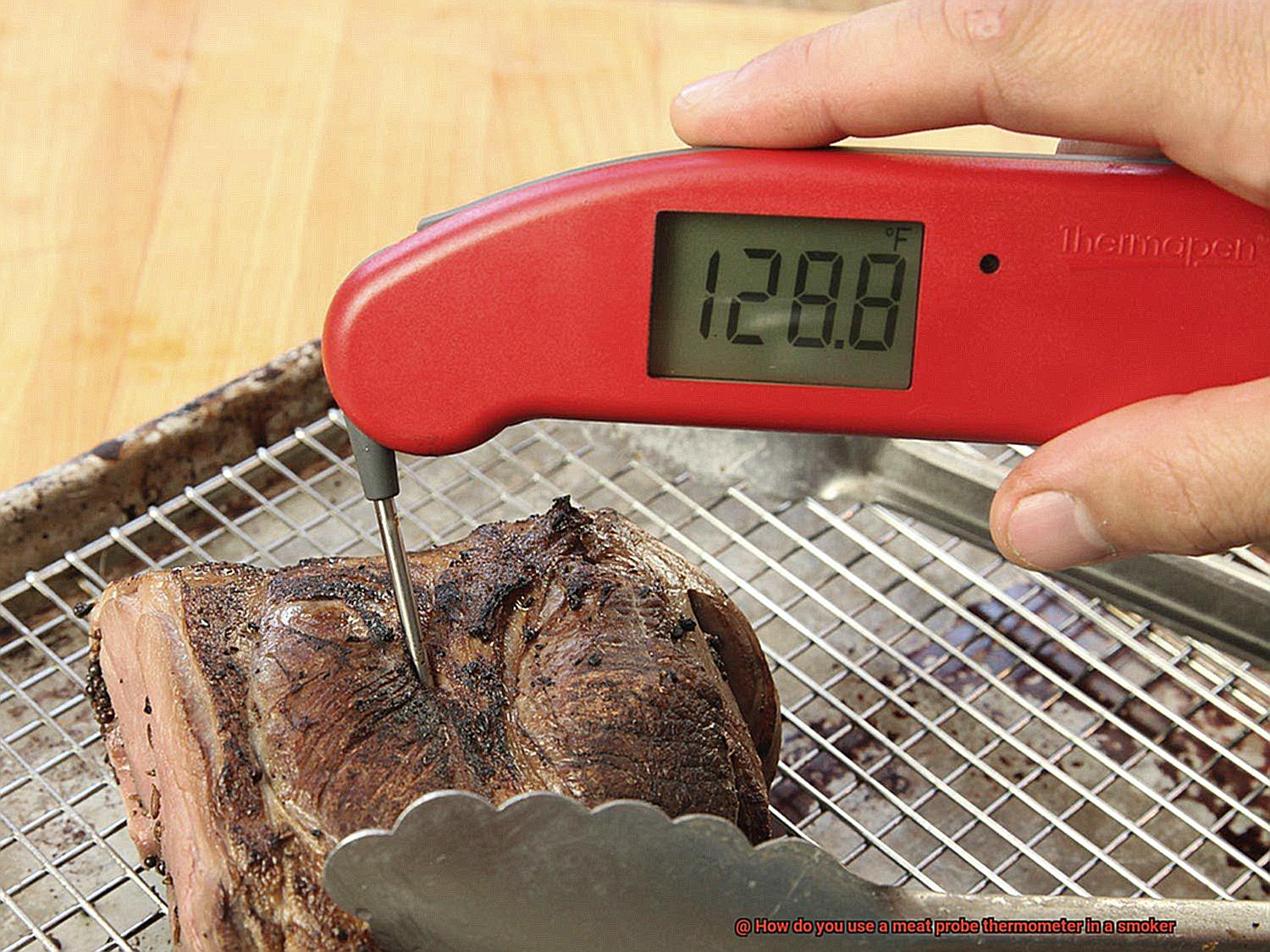
Smoking meats is an art form that requires patience, skill, and the right tools. One such tool is a meat probe thermometer, which can help ensure that your meat is cooked to perfection. Follow these tips on how to use a meat probe thermometer for perfectly cooked smoked meats.
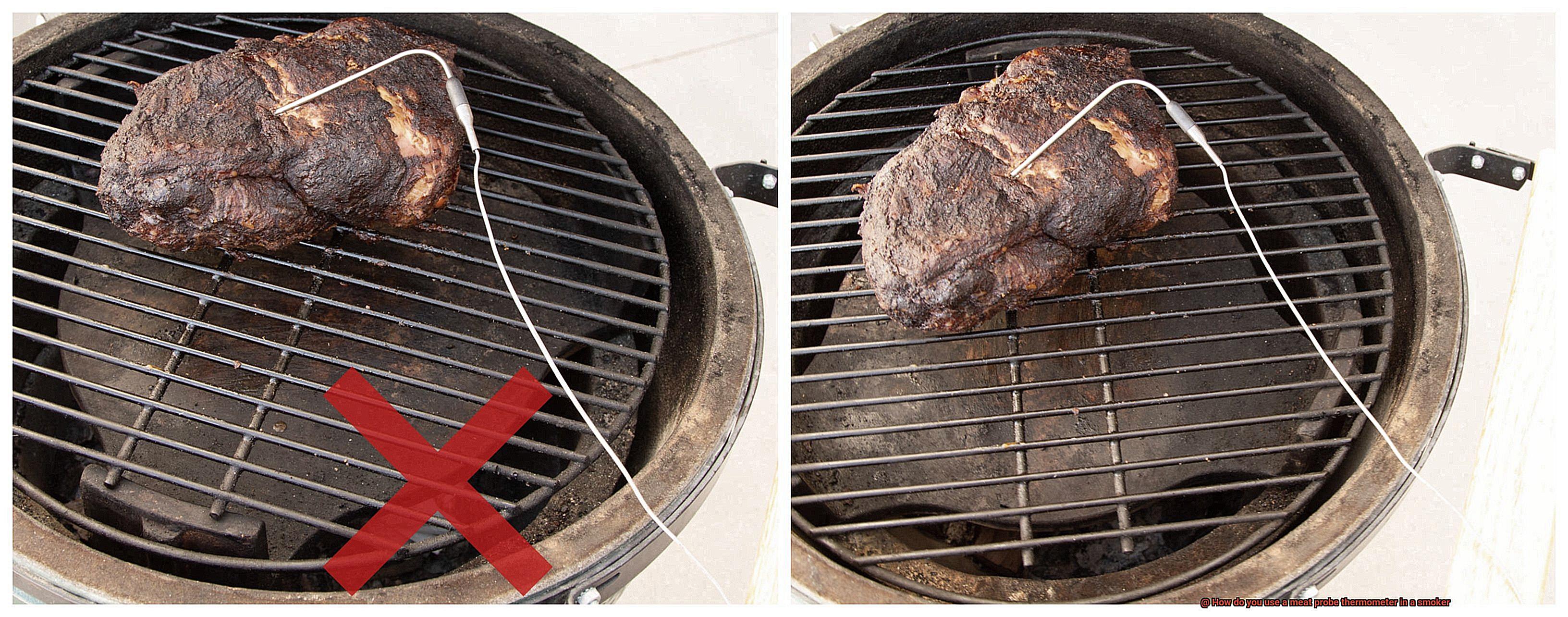
Invest in a high-quality meat probe thermometer
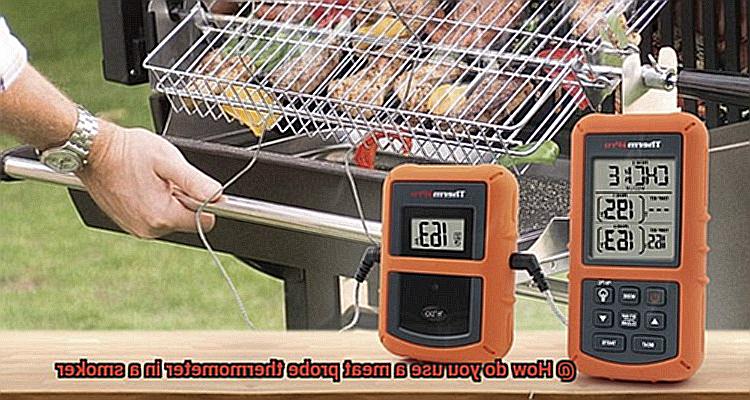
Don’t skimp on quality when it comes to your meat probe thermometer. Look for one with a digital display and a long probe to easily reach the center of your meat. Cheaper models may not be as accurate, which can lead to overcooked or undercooked meat.
Insert the probe properly
To get an accurate reading, insert the probe into the thickest part of the meat, away from any bones or fatty areas. Wait for the reading to stabilize before removing the probe.
Know your target temperature
Different types of meats will have different ideal internal temperatures for doneness. For example, chicken should be cooked to an internal temperature of 165°F, while beef brisket should be cooked to an internal temperature of 195°F. Make sure you know the proper temperature for the type of meat you are smoking and use your meat probe thermometer to monitor it closely.
Maintain a consistent smoker temperature
The temperature of your smoker can also affect the cooking time and doneness of your meat. Use your meat probe thermometer in conjunction with a smoker thermometer to make sure that your smoker is maintaining the proper temperature throughout the cooking process.
Be patient and experiment
Achieving perfectly cooked smoked meats takes time and practice. Don’t be afraid to experiment with different cuts of meat and wood flavors to find what works best for you.
tYvExTn6MS4″ >
Conclusion
To achieve perfectly cooked, juicy meat every time, using a meat probe thermometer in a smoker is an absolute must. It’s not just about choosing the right thermometer, but also preparing the meat for insertion and inserting the thermometer properly. Connecting it to the base unit and placing it outside of the smoker are also crucial steps to follow.
Interpreting readings based on different types of meats is essential, as is ensuring accuracy with calibration checks. Properly cleaning and storing your thermometer will help ensure its longevity.
Investing in a high-quality meat probe thermometer and maintaining consistent smoker temperature are equally important. Knowing your target temperature and being patient while experimenting with different cuts of meat and wood flavors will pay off in mouth-watering results that will impress your friends and family.
By following these guidelines, you’ll unlock the secret to perfectly cooked smoked meats every time.

